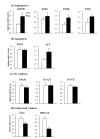Effects of castration on expression of lipid metabolism genes in the liver of korean cattle
- PMID: 25557684
- PMCID: PMC4283181
- DOI: 10.5713/ajas.14.0582
Effects of castration on expression of lipid metabolism genes in the liver of korean cattle
Abstract
Castration induces the accumulation of body fat and deposition of intramuscular fat in Korean cattle, resulting in improved beef quality. However, little is known about the metabolic adaptations in the liver following castration. To understand changes in lipid metabolism following castration, hepatic expression levels of lipid metabolism genes were compared between Korean bulls and steers. Steers had higher (p<0.001) hepatic lipids contents and higher (p<0.01) mRNA levels of lipogenic acetyl-CoA carboxylase. This differential gene expression may, in part, contribute to increased hepatic lipid content following the castration of bulls. However, we found no differences in the hepatic expression levels of genes related to triglyceride synthesis (mitochondrial glycerol-3-phosphate acyltransferase, diacylglycerol O-acyltransferase 1 and 2) and fatty acid (FA) oxidation (carnitine palmitoyltransferase 1A, C-4 to C-12 straight chain acyl-CoA dehydrogenase, very long chain acyl-CoA dehydrogenase) between bulls and steers. No differences in gene expression for very-low-density lipoprotein (VLDL) secretion, including apolipoprotein B mRNA and microsomal triglyceride transfer protein (MTTP) protein, were observed in the liver although MTTP mRNA levels were higher in steers compared to bulls. In conclusion, FA synthesis may contribute to increased hepatic lipid deposition in steers following castration. However, hepatic lipid metabolism, including triglyceride synthesis, FA oxidation, and VLDL secretion, was not significantly altered by castration. Our results suggest that hepatic lipid metabolism does not significantly contribute to increased body fat deposition in steers following castration.
Keywords: Bulls; Gene Expression; Korean Cattle; Liver; Steers.
Figures



Similar articles
-
Expression of fat deposition and fat removal genes is associated with intramuscular fat content in longissimus dorsi muscle of Korean cattle steers.J Anim Sci. 2012 Jun;90(6):2044-53. doi: 10.2527/jas.2011-4753. Epub 2012 Jan 20. J Anim Sci. 2012. PMID: 22266990
-
Transcriptome changes favoring intramuscular fat deposition in the longissimus muscle following castration of bulls.J Anim Sci. 2013 Oct;91(10):4692-704. doi: 10.2527/jas.2012-6089. Epub 2013 Jul 26. J Anim Sci. 2013. PMID: 23893995
-
Hepatic transcriptional changes in critical genes for gluconeogenesis following castration of bulls.Asian-Australas J Anim Sci. 2018 Apr;31(4):537-547. doi: 10.5713/ajas.17.0875. Epub 2018 Feb 21. Asian-Australas J Anim Sci. 2018. PMID: 29502393 Free PMC article.
-
Regulation of energy metabolism by long-chain fatty acids.Prog Lipid Res. 2014 Jan;53:124-44. doi: 10.1016/j.plipres.2013.12.001. Epub 2013 Dec 18. Prog Lipid Res. 2014. PMID: 24362249 Review.
-
Intestinal absorption, blood transport and hepatic and muscle metabolism of fatty acids in preruminant and ruminant animals.Reprod Nutr Dev. 1999 Jan-Feb;39(1):27-48. doi: 10.1051/rnd:19990102. Reprod Nutr Dev. 1999. PMID: 10222498 Review.
Cited by
-
- Invited Review - Factors affecting beef quality and nutrigenomics of intramuscular adipose tissue deposition.Anim Biosci. 2023 Feb;36(2):350-363. doi: 10.5713/ab.22.0380. Epub 2023 Jan 11. Anim Biosci. 2023. PMID: 36634658 Free PMC article.
-
Genetic, management, and nutritional factors affecting intramuscular fat deposition in beef cattle - A review.Asian-Australas J Anim Sci. 2018 Jul;31(7):1043-1061. doi: 10.5713/ajas.18.0310. Epub 2018 May 31. Asian-Australas J Anim Sci. 2018. PMID: 29879830 Free PMC article.
-
The Effects of Oleic Acid and Palmitic Acid on Porcine Muscle Satellite Cells.Foods. 2024 Jul 12;13(14):2200. doi: 10.3390/foods13142200. Foods. 2024. PMID: 39063284 Free PMC article.
-
Genome-wide scan reveals genetic divergence and diverse adaptive selection in Chinese local cattle.BMC Genomics. 2019 Jun 14;20(1):494. doi: 10.1186/s12864-019-5822-y. BMC Genomics. 2019. PMID: 31200634 Free PMC article.
-
Downregulated angiopoietin-like protein 8 production at calving related to changes in lipid metabolism in dairy cows.J Anim Sci. 2018 Jun 29;96(7):2646-2658. doi: 10.1093/jas/sky162. J Anim Sci. 2018. PMID: 29746655 Free PMC article.
References
-
- Anderson N, Borlak J. Molecular mechanisms and therapeutic targets in steatosis and steatohepatitis. Pharmacol Rev. 2008;60:311–357. - PubMed
-
- Bonen A, Chabowski A, Luiken JJ, Glatz JF. Is membrane transport of FFA mediated by lipid, protein, or both? Mechanisms and regulation of protein-mediated cellular fatty acid uptake: Molecular, biochemical, and physiological evidence. Physiology (Bethesda, Md) 2007;22:15–29. - PubMed
-
- Bong JJ, Jeong JY, Rajasekar P, Cho YM, Kwon EG, Kim HC, Paek BH, Baik M. Differential expression of genes associated with lipid metabolism in longissimus dorsi of Korean bulls and steers. Meat Sci. 2012;91:284–293. - PubMed
-
- Chen X, Wang X, Li Z, Kong L, Liu G, Fu J, Wang A. Molecular cloning, tissue expression and protein structure prediction of the porcine 3-hydroxy-3-methylglutaryl-Coenzyme A reductase (HMGR) gene. Gene. 2012;495:170–177. - PubMed
-
- Edwards PA, Kennedy MA, Mak PA. LXRs; oxysterol-activated nuclear receptors that regulate genes controlling lipid homeostasis. Vascul Pharmacol. 2002;38:249–256. - PubMed
LinkOut - more resources
Full Text Sources
Other Literature Sources
Miscellaneous

